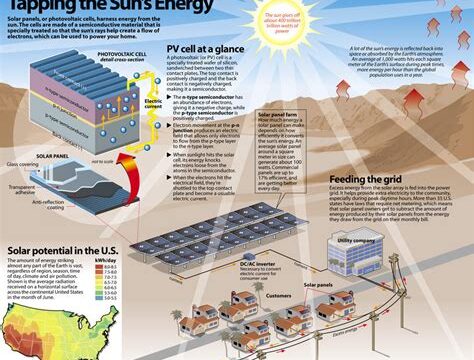Understanding Solar Energy: The Basics Explained
Solar energy is becoming increasingly popular as a renewable and sustainable source of power. Understanding the basics of solar energy can help individuals make informed decisions about utilizing this technology. Solar energy is derived from the sun’s radiation and can be converted into electricity or used directly as heat. The key components of a solar energy system include solar panels, inverters, batteries (optional), and a power meter. The process begins with sunlight hitting the solar panels and converting the photons into direct current (DC) electricity.
This DC electricity is then sent to the inverter, where it is transformed into alternating current (AC) electricity suitable for use in homes and businesses. The excess electricity generated by the solar panels can be stored in batteries for later use or fed back into the electrical grid. To ensure efficient utilization of solar energy, it is crucial to position solar panels in an area that receives ample sunlight throughout the day. The angle and orientation of the panels also play a significant role in maximizing energy production.
When it comes to the types of solar panels, there are primarily three categories: monocrystalline, polycrystalline, and thin-film. Monocrystalline solar panels are the most efficient and expensive option, as they are made from a single silicon crystal structure. Polycrystalline panels are slightly less efficient and more affordable, as they are made from multiple silicon fragments. Thin-film solar panels are the least efficient but also the most cost-effective, as they are made by depositing a thin layer of photovoltaic material onto a substrate.
Solar Panels: How They Work and Their Types
Solar panels play a crucial role in harnessing the power of the sun and converting it into usable electricity. They have become increasingly popular as a sustainable energy source and are widely used in residential, commercial, and industrial settings. In this blog post, we will explain how solar panels work and explore different types of solar panels available in the market.
Solar panels work by utilizing a phenomenon known as the photovoltaic effect. This effect occurs when sunlight hits the solar panels, and the solar cells within the panels absorb the photons (particles of light). The absorbed photons create an electric field across the layers of the solar cells, causing the release of electrons. These electrons are then captured and directed through an external circuit, generating an electric current.
There are several types of solar panels available, each with its own unique characteristics and applications. The most common type is the monocrystalline solar panel, which is made from a single crystal structure. This type of panel offers high efficiency and is ideal for situations where space is limited. Another type is the polycrystalline solar panel, which is made from multiple crystal structures. These panels are less expensive but have slightly lower efficiency compared to monocrystalline panels.
- Monocrystalline Solar Panels: Made from a single crystal structure
- Polycrystalline Solar Panels: Made from multiple crystal structures
- Thin-Film Solar Panels: Made by depositing layers of photovoltaic material onto a substrate
- Concentrated Solar Panels: Use lenses or mirrors to concentrate sunlight onto small areas of high-efficiency solar cells
Each type of solar panel has its advantages and disadvantages, and it’s important to choose the right one based on your specific needs and preferences. Factors such as efficiency, cost, space availability, and installation requirements should be considered when deciding on the type of solar panel to install.
By understanding how solar panels work and the different types available, you can make an informed decision when it comes to adopting solar energy as a sustainable and cost-effective solution for your energy needs. Solar panels not only help reduce dependence on fossil fuels but also contribute to a cleaner environment by producing clean, renewable energy. Embracing solar technology is a step towards a greener future.
Choosing the Right Solar System for Your Home
In today’s world, where environmental concerns are at the forefront of our minds, more and more homeowners are turning to solar energy as a renewable and sustainable source of power. Investing in a solar system for your home not only helps reduce your carbon footprint, but it can also provide long-term financial benefits. However, with so many options available in the market, choosing the right solar system for your home can be a daunting task. In this blog post, we will guide you through the process of selecting the perfect solar system that meets your energy needs and fits your budget.
When it comes to choosing the right solar system for your home, there are several factors to consider. The first step is to determine your energy requirements. Assess your household’s average energy consumption by reviewing your utility bills from the past year. This will give you an idea of how much electricity you need to generate through solar energy. Additionally, consider any future changes or expansions in your energy usage, such as purchasing electric vehicles or adding more appliances to your home.
Once you have a clear understanding of your energy needs, the next step is to evaluate your roof’s suitability for solar panels. An ideal roof for solar installation should have optimal sun exposure throughout the day, minimal shading from trees or nearby structures, and a sturdy structure to accommodate the weight of the solar panels. If your roof does not meet these criteria, you may need to explore alternative options such as ground-mounted solar systems or solar carports.
Now that you have assessed your energy requirements and evaluated your roof’s suitability, it’s time to explore the different types of solar systems available in the market. The two main types of residential solar systems are grid-tied and off-grid systems. Grid-tied systems are connected to the utility grid and allow you to sell excess energy back to the grid, whereas off-grid systems are not connected to the grid and require batteries for energy storage.
After deciding on the type of solar system, consider the size and efficiency of the solar panels. Solar panels come in various sizes and power outputs. It’s crucial to choose a system that can generate enough electricity to meet your energy needs. Additionally, consider the efficiency of the solar panels, which refers to the amount of sunlight they can convert into electricity. Higher efficiency panels may cost more initially, but they can result in greater long-term savings by producing more electricity.
Lastly, don’t forget to take into account your budget and available financial incentives. The cost of installing a solar system can vary depending on factors such as the size of the system, type of panels, and installation complexity. However, with the availability of government incentives, tax credits, and rebates, the upfront costs can be significantly reduced. Research and explore the financial support options available in your region to make solar energy more affordable for your home.
| Factors to Consider | Recommendation |
|---|---|
| Energy Requirements | Assess your average energy consumption and consider future changes. |
| Roof Suitability | Ensure optimal sun exposure, minimal shading, and a sturdy roof structure. |
| Type of Solar System | Choose between grid-tied and off-grid systems based on your needs. |
| Size and Efficiency of Panels | Select panels that generate sufficient electricity and have higher efficiency. |
| Budget and Financial Incentives | Consider upfront costs and explore government incentives and rebates. |
Choosing the right solar system for your home is a significant decision that requires careful consideration of various factors. By understanding your energy requirements, assessing your roof’s suitability, exploring different system types, considering panel size and efficiency, and taking advantage of financial incentives, you can ensure that you make an informed choice. Investing in a solar system not only benefits the environment but also provides long-term savings and energy independence for your home.
Maximizing Solar Energy Efficiency: Tips and Tricks
Solar energy is a renewable and sustainable source of power that has gained significant popularity in recent years. As more and more people embrace solar energy, it is important to focus on maximizing its efficiency to ensure optimum utilization. In this blog post, we will discuss some tips and tricks that can help you maximize the efficiency of your solar energy system.
1. Positioning and Orientation: The positioning and orientation of your solar panels play a crucial role in maximizing their efficiency. It is recommended to install the panels on a south-facing roof or open area where they can receive maximum sunlight throughout the day. Avoid shading from trees, buildings, or other objects that can obstruct the sunlight.
2. Regular Cleaning and Maintenance: Regular cleaning and maintenance of your solar panels are essential to ensure optimal performance. Dust, debris, and bird droppings can reduce the efficiency of the panels by blocking the sunlight. Clean the panels with a soft sponge or cloth and water to remove any dirt or grime. Also, inspect the panels for any damages or loose connections and get them repaired as soon as possible.
3. Use Energy-efficient Appliances: Using energy-efficient appliances and equipment can significantly enhance the overall efficiency of your solar energy system. Look for appliances with energy-saving labels and consider investing in LED lights, energy-efficient refrigerators, and other electronic devices that consume less power.
- 4. Implement Energy-saving Practices:
| Energy-saving Practice | Effectiveness |
| Turning off lights and appliances when not in use | Highly Effective |
| Using natural lighting during the day | Highly Effective |
| Setting the thermostat at an optimal temperature | Moderately Effective |
| Limiting the use of high-energy devices during peak hours | Moderately Effective |
4. Implement Energy-saving Practices: Implementing energy-saving practices can further enhance the efficiency of your solar energy system. Simple actions like turning off lights and appliances when not in use, using natural lighting during the day, setting the thermostat at an optimal temperature, and limiting the use of high-energy devices during peak hours can make a significant difference.
By following these tips and tricks, you can maximize the efficiency of your solar energy system, reduce energy consumption, and contribute towards a greener and more sustainable future. Remember, every effort counts in harnessing the power of solar energy and making a positive impact on the environment.
The Environmental Benefits of Solar Energy
Solar energy is rapidly gaining popularity as a renewable and sustainable energy source. It is a clean and abundant source of power, which makes it environmentally friendly. The environmental benefits of solar energy are significant and cannot be ignored. In this blog post, we will explore the various ways in which solar energy contributes to a greener and more sustainable future.
One of the key environmental benefits of solar energy is its ability to reduce greenhouse gas emissions. Unlike traditional sources of electricity, such as coal and natural gas, solar energy does not release harmful pollutants into the atmosphere. Solar panels harness the power of the sun to generate electricity, which means that no fossil fuels are burned in the process. This leads to a significant reduction in carbon dioxide (CO2) emissions, one of the main contributors to climate change.
Another environmental benefit of solar energy is the conservation of natural resources. Solar power is generated from sunlight, which is an infinite and renewable source of energy. Unlike fossil fuels, which are finite and depleting, sunlight is something that we will always have access to. By relying more on solar energy, we can reduce our dependence on non-renewable resources, such as coal, oil, and natural gas, which are not only environmentally harmful but also limited in supply.
Solar energy also helps to protect ecosystems and wildlife. The extraction and burning of fossil fuels have devastating impacts on the environment. Mining for coal and drilling for oil can lead to habitat destruction, water pollution, and the loss of biodiversity. Furthermore, oil spills and gas leaks can have catastrophic consequences for marine and terrestrial ecosystems. By transitioning to solar energy, we can reduce our impact on the environment and preserve natural habitats for future generations.
- Solar energy reduces greenhouse gas emissions, leading to a decrease in global warming.
- It conserves natural resources, as sunlight is an infinite and renewable source of energy.
- Solar energy helps to protect ecosystems and wildlife by reducing the extraction and burning of fossil fuels.
| Environmental Benefits of Solar Energy |
|---|
| Reduces greenhouse gas emissions |
| Conserves natural resources |
| Protects ecosystems and wildlife |
In conclusion, solar energy offers numerous environmental benefits that make it a viable solution for our energy needs. By harnessing the power of the sun, we can significantly reduce greenhouse gas emissions, conserve natural resources, and protect ecosystems and wildlife. The transition to solar energy is not only beneficial for the environment but also for our long-term sustainability. It is essential that we continue to support and invest in solar energy to create a greener and more sustainable future for generations to come.
Solar Energy Myths vs. Facts: Debunking Common Misconceptions
In today’s modern era, solar energy has become increasingly popular as a sustainable and renewable source of power. However, despite its growing popularity, there are still numerous myths and misconceptions surrounding solar energy. In this blog post, we will debunk some of the most common myths associated with solar energy, and provide you with the facts to help you make informed decisions about adopting solar power.
One of the most prevalent myths about solar energy is that it is only effective in sunny climates. While it is true that solar panels rely on sunlight to produce electricity, they can still generate power on cloudy days or in regions with less sun exposure. Solar panels are designed to capture both direct sunlight and diffuse light, allowing them to generate electricity even when the sun is not shining brightly.
Another myth surrounding solar energy is that solar panels require constant maintenance. In reality, solar panels are relatively low-maintenance and durable. They are built to withstand various weather conditions and can last for decades with minimal upkeep. Occasional cleaning and inspection are usually sufficient to keep solar panels operating efficiently.
Incentives and Government Support for Solar Energy
When it comes to solar energy, one of the factors that can greatly influence its adoption is the availability of incentives and government support. Incentives and government support can play a significant role in making solar energy more affordable and accessible for individuals, businesses, and communities. These programs are designed to encourage the use of renewable energy sources, reduce reliance on fossil fuels, and combat climate change.
There are various types of incentives and government support that can make solar energy more appealing and financially viable. These include tax credits, grants, rebates, and loan programs. Tax credits, for example, can provide a dollar-for-dollar reduction in the amount of income or tax owed. This means that individuals or businesses investing in solar energy systems can receive a significant reduction in their tax liability.
In addition to tax credits, many state and local governments offer grant programs to help cover the upfront costs of solar energy installations. These grants can provide a substantial financial boost and make solar energy more accessible to individuals and communities with limited resources. Rebate programs, on the other hand, involve returning a portion of the cost of a solar energy system to the owner. This can further reduce the overall cost of solar energy installation and incentivize its adoption.
- Increased use of renewable energy sources
- Reduced greenhouse gas emissions
- Energy independence and security
- Job creation and economic growth
- Improved air and water quality
In addition to financial incentives, government support for solar energy can also take the form of policies and regulations. Governments can enact laws and regulations that promote the use of solar energy and create a favorable environment for its growth. These policies can range from setting renewable energy targets to implementing net metering programs.
Net metering, for example, allows solar energy system owners to earn credits for excess electricity they generate and feed back to the grid. These credits can then be used to offset the cost of electricity when the solar system is not generating enough power, such as during nighttime or cloudy days. Net metering programs can provide an additional financial benefit to solar energy system owners and encourage the installation of more solar panels.
| Key Benefits of Incentives and Government Support for Solar Energy |
|---|
| Increased use of renewable energy sources |
| Reduced greenhouse gas emissions |
| Energy independence and security |
| Job creation and economic growth |
| Improved air and water quality |
Overall, incentives and government support for solar energy are crucial in accelerating its adoption and making it a viable alternative to traditional energy sources. By offering financial incentives, policies, and regulations, governments can create a favorable environment for individuals and businesses to invest in solar energy systems. This not only benefits the environment by reducing greenhouse gas emissions but also stimulates economic growth and creates jobs in the renewable energy sector.
Solar Energy Storage Solutions: Battery Technology Advances
As solar energy continues to gain prominence as a sustainable and efficient source of power, the need for effective energy storage solutions becomes more crucial. The availability of solar power is dependent on weather conditions and the time of day, making it essential to store excess energy for future use. This is where battery technology advances play a vital role in maximizing the benefits of solar energy. In this blog post, we will explore the latest developments in solar energy storage solutions and how they contribute to the advancement of renewable energy.
One of the most significant advancements in solar energy storage is the improvement of battery technology. Batteries have traditionally been used to store energy, but recent innovations have made them more efficient and cost-effective. Lithium-ion batteries are one such example, offering high energy density, long lifespan, and fast charging capabilities. These batteries are widely used in various applications, including electric vehicles and renewable energy systems, due to their reliability and ability to store large amounts of energy.
In addition to lithium-ion batteries, other battery technologies such as flow batteries and solid-state batteries are also emerging as promising solutions for solar energy storage. Flow batteries, also known as redox flow batteries, store energy in the form of liquid electrolytes. They offer scalability, long cycle life, and the ability to store vast amounts of energy, making them suitable for grid-scale applications. On the other hand, solid-state batteries use solid electrolytes instead of liquid or gel electrolytes, offering higher energy density, enhanced safety, and faster charging capabilities. These advancements in battery technology expand the options available for solar energy storage, allowing for more efficient and reliable systems.
- Improved energy storage capacity
- Enhanced battery lifespan
- Faster charging capabilities
- Greater safety features
| Battery Technology | Advantages |
|---|---|
| Lithium-ion batteries | High energy density, long lifespan, fast charging |
| Flow batteries | Scalability, long cycle life, large energy storage capacity |
| Solid-state batteries | Higher energy density, enhanced safety, faster charging |
These battery technology advances provide numerous benefits for solar energy storage systems. By improving energy storage capacity, more solar energy can be stored and used during periods of low sunlight or high energy demand. Enhanced battery lifespan ensures longer-lasting and more sustainable energy storage solutions, reducing the need for frequent replacements. Faster charging capabilities enable quicker replenishment of energy storage, allowing for a more efficient usage experience.
Furthermore, the greater safety features offered by advanced battery technologies mitigate the risk of accidents or malfunctions, making solar energy storage systems a safer choice for homes and businesses. The advancements in battery technology not only contribute to the growth of solar energy, but also have positive implications for the wider adoption of renewable energy sources.
In conclusion, solar energy storage solutions have undergone significant advancements in battery technology, revolutionizing the way we harness and utilize solar power. The availability of improved energy storage capacity, enhanced battery lifespan, faster-charging capabilities, and greater safety features facilitate the efficient integration of solar energy into our everyday lives. As these battery technology advances continue to evolve, the future of solar energy storage looks promising, paving the way for a cleaner and more sustainable future.
Frequently Asked Questions
1. How do solar panels work?
Solar panels work by converting sunlight into electricity using photovoltaic cells. These cells are made up of semiconductor materials that generate an electric current when exposed to photons from the sun.
2. What types of solar panels are available?
There are several types of solar panels available, including monocrystalline, polycrystalline, thin-film, and bifacial panels. Monocrystalline panels are made from a single crystal structure and are known for their high efficiency, while polycrystalline panels are made from multiple crystal structures and tend to be more affordable.
3. How can I choose the right solar system for my home?
Choosing the right solar system for your home involves considering factors such as your energy needs, available roof space, and budget. It’s recommended to consult with a solar energy professional who can assess your specific requirements and provide customized recommendations.
4. What are some tips and tricks to maximize solar energy efficiency?
To maximize solar energy efficiency, you can ensure that your solar panels are properly cleaned and maintained, optimize the positioning and angle of the panels for maximum sunlight exposure, and invest in energy-efficient appliances and lighting.
5. What are the environmental benefits of solar energy?
Solar energy has several environmental benefits, including reduced greenhouse gas emissions, decreased reliance on fossil fuels, and conservation of natural resources. It also helps in reducing air and water pollution, as solar power generation doesn’t produce harmful emissions.
6. What are some common misconceptions about solar energy?
Some common misconceptions about solar energy include the belief that it’s expensive, inefficient, and only works in sunny climates. In reality, solar energy costs have significantly decreased over the years, efficiency rates have improved, and solar panels can generate electricity even in cloudy conditions.
7. Are there any incentives or government support for solar energy?
Yes, there are various incentives and government support programs for solar energy. These can include tax credits, grants, feed-in tariffs, and net metering, which allow solar energy system owners to sell excess electricity back to the grid. It’s important to research and understand the specific incentives and support available in your region.
8. How has battery technology advanced for solar energy storage?
Battery technology for solar energy storage has advanced significantly, with the development of more efficient and durable batteries. Lithium-ion batteries are commonly used for solar energy storage, providing reliable backup power and the ability to store excess solar energy for use during periods of low sunlight.





